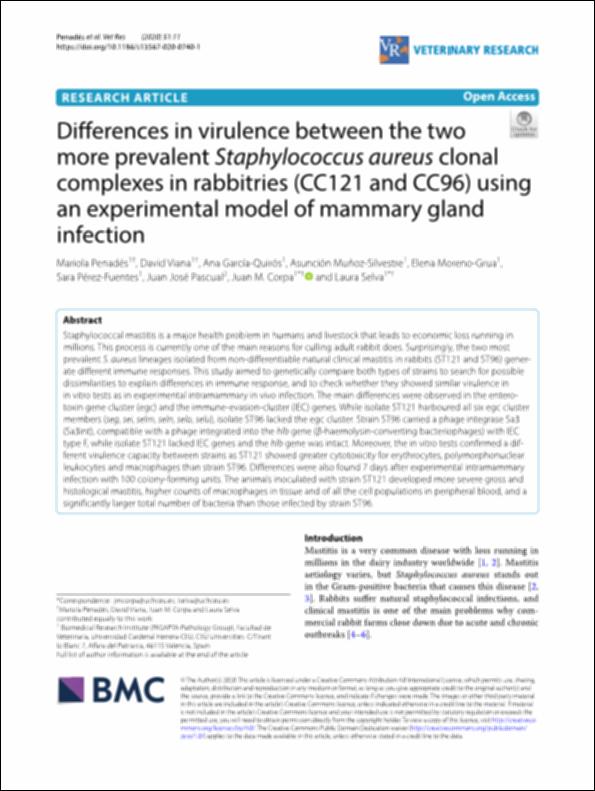Please use this identifier to cite or link to this item:
http://hdl.handle.net/10637/12787Differences in virulence between the two more prevalent "Staphylococcus aureus" clonal complexes in rabbitries (CC121 and CC96) using an experimental model of mammary gland infection
| Title: | Differences in virulence between the two more prevalent "Staphylococcus aureus" clonal complexes in rabbitries (CC121 and CC96) using an experimental model of mammary gland infection |
| Authors : | Penadés Fons, Mariola Viana Martín, David García Quirós, Ana Muñoz Silvestre, Asunción Moreno Grúa, Elena Pérez Fuentes, Sara Pascual Amorós, Juan José Corpa Arenas, Juan Manuel Selva Martínez, Laura |
| Keywords: | Bacteriología veterinaria.; Mastitis.; Glándulas mamarias - Inflamación.; Mammary glands - Inflammation.; Estafilococos.; Conejos - Enfermedades.; Staphylococcus.; Rabbits - Diseases.; Veterinary bacteriology. |
| Publisher: | Springer Nature. |
| Citation: | Penadés, M., Viana, D., García-Quirós, A., Muñoz-Silvestre, A., Moreno-Grua, E., Pérez-Fuentes, S. et al. (2020). Differences in virulence between the two more prevalent Staphylococcus aureus clonal complexes in rabbitries (CC121 and CC96) using an experimental model of mammary gland infection. Veterinary Research, vol. 51, art. 11 (13 feb.). DOI: https://doi.org/10.1186/s13567-020-0740-1 |
| Abstract: | Staphylococcal mastitis is a major health problem in humans and livestock that leads to economic loss running in millions. This process is currently one of the main reasons for culling adult rabbit does. Surprisingly, the two most prevalent S. aureus lineages isolated from non-differentiable natural clinical mastitis in rabbits (ST121 and ST96) generate different immune responses. This study aimed to genetically compare both types of strains to search for possible dissimilarities to explain differences in immune response, and to check whether they showed similar virulence in in vitro tests as in experimental intramammary in vivo infection. The main differences were observed in the enterotoxin gene cluster (egc) and the immune-evasion-cluster (IEC) genes. While isolate ST121 harboured all six egc cluster members (seg, sei, selm, seln, selo, selu), isolate ST96 lacked the egc cluster. Strain ST96 carried a phage integrase Sa3 (Sa3int), compatible with a phage integrated into the hlb gene (β-haemolysin-converting bacteriophages) with IEC type F, while isolate ST121 lacked IEC genes and the hlb gene was intact. Moreover, the in vitro tests confirmed a different virulence capacity between strains as ST121 showed greater cytotoxicity for erythrocytes, polymorphonuclear leukocytes and macrophages than strain ST96. Differences were also found 7 days after experimental intramammary infection with 100 colony-forming units. The animals inoculated with strain ST121 developed more severe gross and histological mastitis, higher counts of macrophages in tissue and of all the cell populations in peripheral blood, and a significantly larger total number of bacteria than those infected by strain ST96. |
| Description: | Este artículo se encuentra disponible en la siguiente URL: https://veterinaryresearch.biomedcentral.com/track/pdf/10.1186/s13567-020-0740-1.pdf |
| URI: | http://hdl.handle.net/10637/12787 |
| Rights : | http://creativecommons.org/licenses/by/4.0/deed.es |
| ISSN: | 0928-4249. 1297-9716 (Electrónico). |
| Issue Date: | 13-Feb-2020 |
| Center : | Universidad Cardenal Herrera-CEU |
| Appears in Collections: | Dpto. Producción y Sanidad Animal, Salud Pública Veterinaria y Ciencia y Tecnología de los Alimentos |
Items in DSpace are protected by copyright, with all rights reserved, unless otherwise indicated.


